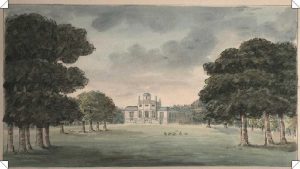The Observatory and Obelisks, Kew – [Local History Notes: 5]
The Observatory was built for George III, a keen amateur astronomer. The architect was Sir William Chambers (1726-1796) who also designed the Pagoda in Kew Gardens.

Built of Portland stone and surmounted with a moveable dome inside which were the main telescopes, it was completed in time for the King to watch the transit of Venus (i.e. when Venus was positioned between the Earth and the Sun) on 3 June 1769.
The Observatory was used as an educational centre by the princes and the King established his own workshop there. The first Royal Observer to be appointed was Stephen Charles Triboudet Demainbray, who held the post from 1769 to 1782. He was assisted by his son the Rev. Demainbray who became teacher of astronomy to the King’s children.
The three obelisks which stand in the Old Deer Park are meridian marks set up for the purpose of adjusting the transit instruments in the Observatory, one pillar corresponding to the east wing of the building, one to the west wing and the solitary obelisk, along the towing path towards Brentford, indicating the true north point of the Observatory. At one time, London’s official time was set from the calculations made at Kew. The principal time-piece used was made by Benjamin Vulliamy, clock-maker to the King. Later this work was taken over by the Observatory at Greenwich.
In 1795 John Little, who was at one time a curator at the Observatory, was hanged for the murder of two old people in Richmond, and was also suspected of having caused the death of a man named Stroud, whose body was found under an iron vice in the octagon room of the building. This man, Little, had often been George III’s only attendant when he walked in the gardens.
The Institution remained royal property until 1840. In 1841 it was closed and much of the contents, including George III’s collections of instruments and Queen Charlotte’s natural history collection, were removed from the building and dispersed to various places. Many of the instruments are now in the Science Museum. The British Association controlled the Observatory from 1842 to 1871, in which year it came under the jurisdiction of the Royal Society. The National Physical Laboratory, an organisation which had just then come into being, took over the management in 1900 and, finally, the Meteorological Office assumed control from July 1910. Nowadays, therefore, the work of Kew Observatory is devoted to weather observations.
More information on the Observatory at Kew and other historic buildings in the London Borough of Richmond upon Thames is available from the Local Studies Library & Archive.
